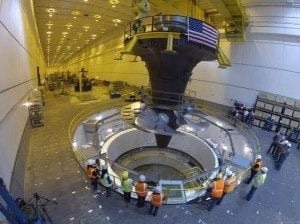Advanced Turbine Design
Summary

From 2002-2013, Grant PUD installed ten new Advanced Turbine Designs at Wanapum Dam on the Mid-Columbia River. The goals of the project were to address the mechanical and hydraulic issues, reduce maintenance, increase generation efficiency, and address fish survival concerns.
The new design included a six-blade Kaplan runner with a spherical hub, new wicket gates, reshaped stay vanes and modifications to the existing draft tubes. These changes improve flow stability, increase hydroelectric capacity and minimize impacts to young salmon.
Best available data reveals that the new design increases generation by an average 3.3 percent. This could allow Grant PUD to deliver clean energy to over 8,000 additional homes. In addition to hydroelectric improvements, available fish passage tests show a slight increase in salmon survival rates.
Background
Built in 1963, Wanapum Dam has delivered clean energy throughout the Pacific Northwest for over 50 years; yet after decades of operation, equipment began to show accelerated signs of wear and deterioration. The original Kaplan (adjustable) turbines began to require frequent, costly maintenance and reliability of the units concerned plant operators. These problems resulted in excessive outages and costly generation loss.
The new advanced turbine design was finalized in 2002 after a decade of research and collaboration among fishery scientists, engineers, utility operators, and the United States Department of Energy. Installation of the first unit was completed in early 2005. Following installation of this unit FERC required a fish passage study prior to proceeding with the remaining nine units.
Challenge
Balancing the needs of existing generation demands, while removing turbines from service, required meticulous monitoring and coordination of over 800 individual tasks throughout the construction process. Each specific task had its own subset of deadlines requiring daily monitoring, scheduling and coordination among engineers, technicians, contractors, inspectors, mechanics and administrative staff.
Many of the scheduling and communication challenges were compounded by the globalization of the supply chain associated with this project. The turbine manufacturer, Voith, had subcontractors manufacture many of the major components in Virginia, Washington, Pennsylvania, Czech Republic, Romania, Brazil and Slovenia.
Every design modification to the turbines and the structure of the dam had to take ESA-listed species into consideration before the solution could be implemented. These biological challenges associated with the project required over 150 different research studies related to salmon behavior in the area.
Innovation
The innovation developed and implemented on the new turbine comes from a collaborative relationship between Grant PUD, Voith Hydro, Inc. and the U.S. Department of Energy. Every design solution had to balance the varied objectives of energy efficiency, cost effectiveness and biological concerns throughout the process.
The design of the new runner (which includes the hub and the blades) incorporates a number of features intended to improve the survival of juvenile salmon passing through the units, along with increased turbine efficiency.
A key element of the design is the increase in the number of blades from five to six, and lowering the blade elevation. These changes significantly reduce a phenomenon known as cavitation which causes metal to corrode on the blades over time and decreases overall efficiency.
The new design captures the entire hydraulic passageway at Wanapum Dam, not just the turbines. Engineers modified the stay vanes, wicket gates and draft tubes to achieve a smooth flow of water, which naturally improves fish passage.
Results
The new turbines have a rated capacity of 112 megawatts at 80 feet of head or 150,000 horsepower. By comparison, the original turbines were rated at 90 megawatts at 80 feet of head or 120,000 horsepower. The best available data reveals that our new advanced turbine design increases power generation and improves efficiency by an average of 3.3 percent, or 20 average megawatts. This new, “incremental” hydropower is one of the most cost-effective resources available and could allow us to provide clean hydroelectric energy to over 8,000 additional homes.
Grant PUD’s advanced-design turbine testing needed to achieve a fish passage survival rate that was equal to or exceeded the survival through an existing turbine, which at the time was 97.7 percent. In addition to the improved turbine efficiency, a final report on the fish passage tests show juvenile salmon survival rates slightly improved (97.8 percent) compared to the previous units, thus meeting the FERC-mandated goal.
Stakeholder Quotes
“I am pleased that PUD No. 2 of Grant County was able to use new technology to both increase capacity and protect fish. We need more clean power in the country, while we conserve our valuable natural resources. This is a win-win for everyone.” – Pat Wood III, Former FERC Chariman


